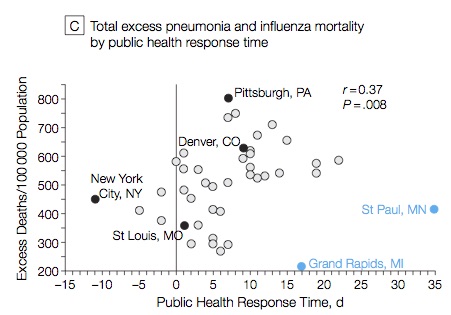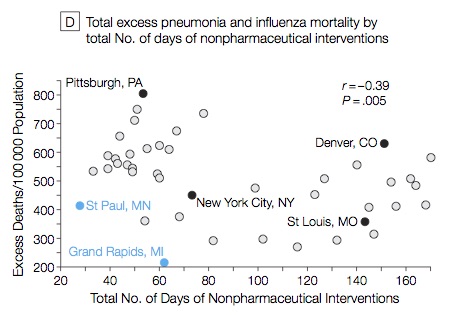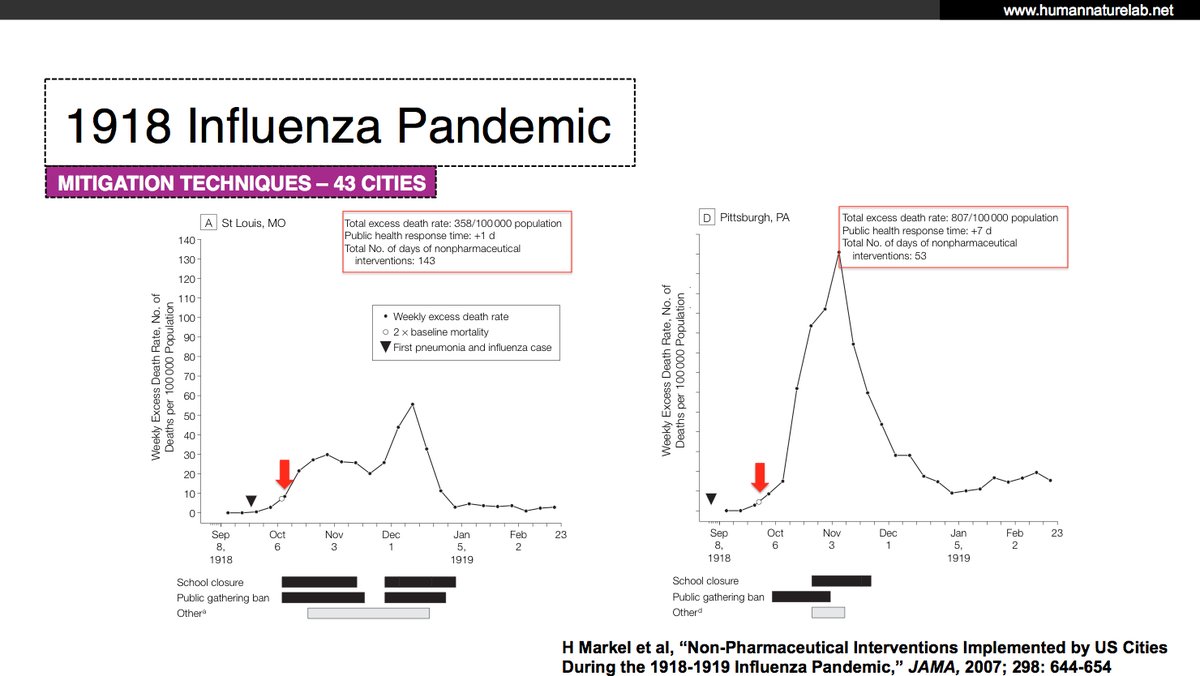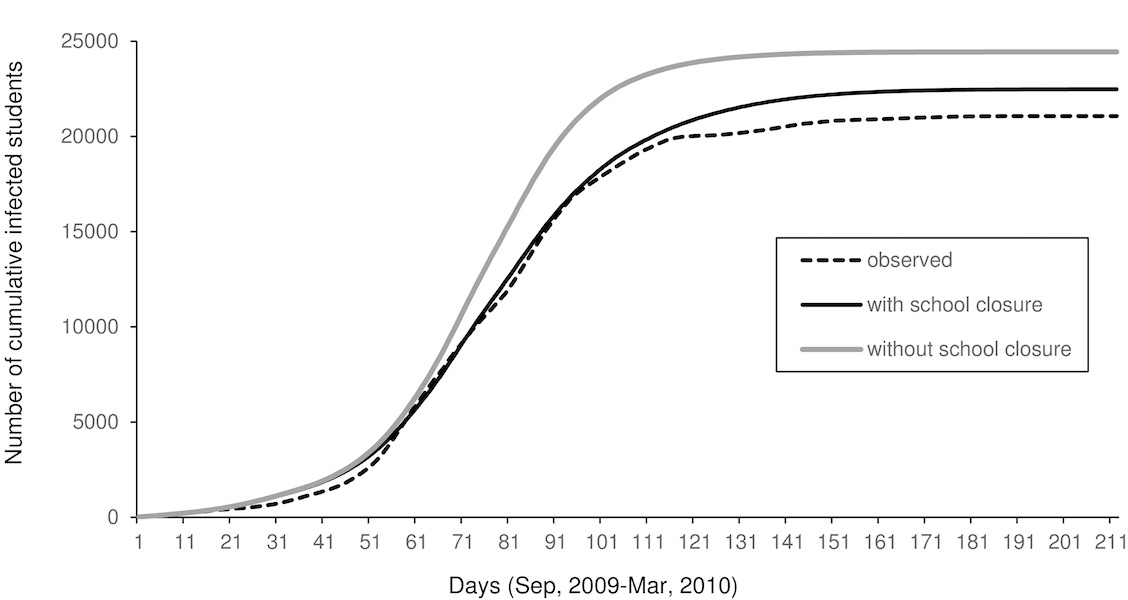Let& #39;s talk about school closures re COVID-19. It& #39;s a tough topic, scientifically and pragmatically. It& #39;s hard to estimate the benefits precisely. And closing schools can have costs, such as health care workers having to stay home, kids missing subsidized lunches, etc. 1/
Yet studies show that school closures are one of the most beneficial & #39;non-pharmaceutical interventions& #39; (NPI) that can be employed, more effective even than reactive quarantines or banning of public gatherings. Partly, the reason is that *parents* also stay home as a result. 2/
An inventive 2007 study by @HowardMarkel et al in @JAMA_current examined impact of school closures and other NPI, and their precise timing, in the 1918 influenza pandemic, looking at 43 major USA cities. https://jamanetwork.com/journals/jama/fullarticle/208354">https://jamanetwork.com/journals/... 3/
The *earlier* that schools were closed (ideally even in *advance* of outbreaks) the lower the number of excess deaths in 43 US cities during the 1918 Influenza pandemic. #COVID19 #schoolclosure 4/
The *longer* that school closings and other non-pharmaceutical interventions (NPI) were applied in each of 43 US cities during the 1918 influenza pandemic, the lower was the ultimate mortality rate. #COVID19 #schoolclosure 5/
But school closures and NPI must be applied *early*. Compare St. Louis and Pittsburg in the 1918 influenza pandemic. St. Louis closed its schools *before* local cases had doubled, and for longer, than Pittsburg. It had many fewer excess deaths. #COVID19 #schoolclosure 6/
Detailed modeling of NPI in 2006 @nature paper shows that if school closure is *reactive* (waiting for first case and then closing 100% of schools), with moderately transmissible virus, cumulative cases decline 26% & epidemic peak is delayed 16 days. https://www.nature.com/articles/nature04795">https://www.nature.com/articles/... 7/
So reactive school closure, while rational & helpful, is not enough. In my view, schools should be closed *before* first case in a school, when cases appear in the community or in nearby areas. This is not without costs. But waiting reduces the benefits of #schoolclosure. 8/
Japan closed *all* its schools in the entire nation last week, and plans to keep them closed through April. This is a dramatic move, which, depending on how things go with #COVID19 worldwide, may prove to have been a sage & effective intervention. https://english.kyodonews.net/news/2020/03/9116ab05810c-nearly-all-prefectures-shut-schools-over-virus-outbreak.html">https://english.kyodonews.net/news/2020... 9/
On the other hand, Singapore hasn’t used #schoolclosure and is implementing temperature checks and hand washing. Via @mira_debs https://www.straitstimes.com/singapore/health/no-plans-to-close-schools-for-now-says-education-minister-ong-ye-kung">https://www.straitstimes.com/singapore... 10/
Italy closes schools nationwide. https://www.bbc.com/news/world-europe-51743697">https://www.bbc.com/news/worl... If one thinks one will close schools when cases strike, it’s better to close earlier than later. That is, close them when cases occur in nearby areas. By time there are index cases in schools themselves, it’s late. 11/
Model of #schoolclosure for H1N1, striking population w school system & demography of Italy, indicates reactive *phased* policy of closing classes, then grades, then schools, might be nearly as effective as closing schools. I& #39;m skeptical https://bmcinfectdis.biomedcentral.com/track/pdf/10.1186/s12879-016-1918-z">https://bmcinfectdis.biomedcentral.com/track/pdf... | @alainbarrat 12/
Analysis of school closures in Japan during pandemic H1N1 flu in 2009 showed an impact: cumulative number of infected *students* decreased by 8% and maximum peak by 24% (flattening epidemic with NPI -- non-pharmaceutical interventions). #schoolclosures https://journals.plos.org/plosone/article?id=10.1371/journal.pone.0144839">https://journals.plos.org/plosone/a... 13/
School closures slow epidemics even if kids are not susceptible. But closures really help if kids can get sick. New analyses from China reveal that children can indeed get #COVID19 (though most studies show at very low rates). https://www.medrxiv.org/content/10.1101/2020.03.03.20028423v1">https://www.medrxiv.org/content/1... via @cmyeaton 14/
Here is the current (as of March 5, 2020) guidance from the @CDCgov regarding school closures, which is *very* gently worded. https://www.cdc.gov/coronavirus/2019-ncov/specific-groups/guidance-for-schools.html">https://www.cdc.gov/coronavir... 15/
Example of reactive school closure when proactive would be better. If you plan to close the school when there is a case, and if there are already community-acquired cases in the epidemiologically relevant region around you, proactive closure is better https://twitter.com/business/status/1237140620134756358?s=21">https://twitter.com/business/... 16/ https://twitter.com/business/status/1237140620134756358">https://twitter.com/business/...
NYC infectious disease experts strongly endorse closing NYC schools in an open letter to the Mayor. https://twitter.com/paulbieniasz/status/1238188033452789767?s=21">https://twitter.com/paulbieni... 17/
Useful interactive map of school closures throughout the USA updated daily. Via @educationweek h/t @pauldiperna https://www.edweek.org/ew/section/multimedia/map-coronavirus-and-school-closures.html?override=web">https://www.edweek.org/ew/sectio... 18/
Using syndromic surveillance, @mandl et al showed that, for influenza, it’s kids first (red), then adults (blue), then deaths from influenza—mostly in the elderly (black). This is one reason closing schools helps. https://www.ncbi.nlm.nih.gov/pmc/articles/PMC4128871/">https://www.ncbi.nlm.nih.gov/pmc/artic... #schoolclosure 19/
If the school is simply unable or unwilling to close, though I think they should, there are a few things it can do to reduce social contact at the school, and which it should therefore do right away. Some ideas in @TheAtlantic with @ErikaChristakis: https://www.theatlantic.com/ideas/archive/2020/03/coronavirus-closing-schools-not-only-option/608056/">https://www.theatlantic.com/ideas/arc... 20/

 Read on Twitter
Read on Twitter






